Clinical Characteristics and Properties of Ceramic Brackets a Comprehensive Review
- Inquiry
- Open Access
- Published:
Cess of chemic, ultrasonic, diode laser, and Er:YAG laser application on debonding of ceramic brackets
BMC Oral Health volume 22, Article number:79 (2022) Cite this article
Abstract
Background
Risk of enamel impairment that often accompanies ceramic brackets debonding raises the demand of finding an optimal method for debonding of them without adverse effects. Unlike techniques were proposed in an attempt to facilitate their debonding. Comparing of these techniques is crucial. The aim of this study was to evaluate and compare different techniques for debonding of ceramic brackets in terms of shear bond strength and adhesive remnant index.
Materials and methods
A full of 100 extracted premolars were randomly allocated into 5 groups. Ceramic brackets were so bonded to teeth using light cure composite resin. Among test groups; group I: served equally command, grouping Two: chemical aided debonding via peppermint oil, group 3: ultrasonic aided debonding, group IV: diode laser aided debonding, and grouping V: Er:YAG light amplification by stimulated emission of radiation aided debonding. Brackets were shear tested using universal testing car followed by ARI assessment and evaluation of enamel microstructure was performed using scanning electron microscopy.
Results
A significantly lower shear bond strength was establish in ultrasonic, diode, and Er:YAG laser groups. Withal, no significant deviation was found in the chemic group. A significantly higher agglutinative remnant index was found solely in Er:YAG laser group with minimal enamel microstructure alterations.
Conclusions
Er:YAG laser is a promising tool in debonding ceramic brackets. Ultrasonic and diode laser significantly reduced shear bail strength. All the same, adhesive remnant index in both groups revealed no deviation. Chemical aided debonding had piffling effect and hence, it cannot be recommended without further development.
Introduction
The advent of ceramic brackets in orthodontics three decades ago was a consequence of the increased number of adult patients seeking orthodontic treatment with less visible appliances [1]. Despite beingness superior in esthetics, ceramic brackets exhibited higher bond strength and lower fracture toughness in comparison to metallic brackets, thus inducing challenges during debonding including enamel tear outs, minute fractures, and cracks [2,3,4].
Throughout history, attempts have been fabricated to overcome difficulties encountered during debonding, decrease patient discomfort, and proceed the bond failure site confined to bracket-adhesive interface. Therefore, broad diversity in terms of debonding techniques were suggested [v,6,7]. The use of electrothermal debonding technique was proposed for ceramic brackets debonding with controlled estrus application [8, 9]. This method resulted in meaningful thermal softening of the agglutinative, allowing easier debonding without immoderate forcefulness [10]. Even so, it raised the concern nigh possible pulpal injury [xi]. Custom fabricated especially designed pliers accept been introduced with the idea of awarding of squeezing force [12]. All the same, patient discomfort and enamel damage remained inevitable [13, fourteen].
On the opposite, literature reported the safety of debonding ceramic brackets using ultrasonic technique [15]. In essence, using ultrasonic tips were claimed to be price-effective, every bit the tips used for debonding of ceramic brackets could be used later for removing adhesive remnants [16, 17]. Yet, the significant increase in debonding time remained one of the shortcomings [15].
Various chemical agents have been used for debonding of ceramic brackets with the thought of reducing the required debonding strength and hence facilitating removal of the brackets [eighteen]. Awarding of peppermint oil prior to debonding of ceramic brackets yielded contradictory results; with some reported promising results [18] and others showed no statistically significant difference compared to command [nineteen]. Other authors claimed that peppermint oil altered the site of bond failure and somewhen reduced the risk of enamel damage [20]. Inconsistent results with different application time and adhesive resin types were reported, necessitating further investigations [18,19,20].
Laser irradiation of ceramic brackets have been evaluated in several studies. For example, carbon dioxide light amplification by stimulated emission of radiation (CO2) [21,22,23], ytterbium cobweb laser, neodymium-doped yttrium–aluminium garnet (Nd:YAG) [24,25,26], Erbium, chromium-doped yttrium, scandium, gallium and garnet (Er,Cr:YSGG) [26,27,28], erbium-doped yttrium aluminum garnet (Er:YAG) [29,30,31], and diode light amplification by stimulated emission of radiation [32,33,34,35] were investigated. Mode of activity of lasers was reported to be via thermal ablation, photoablation, or thermal softening [29, xxx]. Light amplification by stimulated emission of radiation aided debonding raised the concern of potential pulp injury every bit a consequence of raised intrapulpal temperature [32,33,34,35]. No statistically significant difference was reported when continuous and pulsed manner were compared [36]. Yet, super pulse yielded superior results in comparing to normal pulse [23, 32].
Light amplification by stimulated emission of radiation aided debonding of ceramic brackets accept proved its efficiency [35]. With regard to the thermal outcome that is oftentimes accompanied with laser irradiation, Er:YAG showed success over Nd:YAG and COii lasers [21]. In fact, Er:YAG revealed the ability to be directly absorbed by the agglutinative resin without detrimental consequences on the pulpal tissues [37, 38]. Given the relatively compact size and low weight of diode light amplification by stimulated emission of radiation, using it for aided debonding of ceramic brackets would exist a privilege [39].
Great business concern should be made on reduction of the adverse effects that is often concomitant with ceramic brackets debonding. Yet, there is scarcity of studies with the aim of investigation and comparing of ultrasonic, chemical, and laser aided debonding of ceramic brackets to a control group. Finding an optimal method for debonding ceramic brackets without subversive effects on the enamel is of utmost importance. This would provide dandy insight for orthodontists on how to reduce patient discomfort that usually accompanies ceramic brackets debonding.
The aim of this study was to evaluate and compare the effects of chemical amanuensis (peppermint oil), ultrasonic instrumentation, diode light amplification by stimulated emission of radiation, and Er:YAG laser application on debonding of ceramic brackets in terms of shear bond force (SBS) and adhesive remnant index (ARI).
Methods
The study was approved by the institutional review board at the Faculty of Dentistry, Alexandria Academy (IRB:00010556–IORG:0008839). Informed consent was obtained from all subjects or legal guardians. All the methods were carried out in accordance with CRIS guidelines and regulations. This randomized controlled in vitro study was conducted at Alexandria and Ain Shams University.
Sample training and intervention
Sample size estimation was calculated using power and sample size calculation calculator software (Epi-Info 7 software, Atlanta, GA, Us). At α = 0.05 and with a power of 0.95, a minimum of 15 teeth per group was required [30]. In order to cater for any harm during the study, 20 premolars per group was used. A full of 100 audio man premolars extracted for orthodontic reasons with intact buccal surface were collected. Patients or their local guardian were informed then signed written consent to permit the use of the teeth. Teeth with carious lesion, restoration, fracture, visible cracks, or hypoplastic lesions were excluded. Teeth were cleaned with tap h2o and then stored in 0.9% isotonic saline solution. This was followed by random resource allotment using Random Allocation Software (Version ane.0) [32]. into one of the 5 groups. The buccal surface of the teeth was polished using prophylactic cup with non-fluoridated oil-free pumice and water, so rinsed and dried with oil/moisture-gratis air spray. Thereafter, etching of the buccal surface of the teeth was done using 37% phosphoric acid (Denfil, Vericom, South korea) for 30 southward, rinsed thoroughly with water spray for 20 south, and then dried with oil/wet-free air spray until the enamel had chalky white appearance. In group I, monocrystalline ceramic brackets (Perfect Articulate, Hubit, Republic of korea) were bonded to the center of the buccal surface using the ane pace GC Ortho Connect adhesive (GC Ortho Connect, GC Orthodontics, Germany) that incorporates the primer into the paste, and so firmly pressed, subjected to a 300 g compressive force using a force gauge (Morelli, SP, Brazil) and excess agglutinative was removed with a sharp explorer. The adhesive was then light cured with a LED curing light (True dent, Guangzhou, China) for twenty s. Subsequently the bonding procedure, teeth were stored in a distilled h2o for 24 h. The roots of the teeth were then embedded in self cure acrylic resin blocks leaving the crown exposed. In grouping 2, teeth were bonded and then mounted using the same technique employed for group I. Peppermint oil (Peppermint Essential Oil, Areej, Egypt) was applied on the mesial, distal, occlusal, and gingival surface of the brackets for x min. (Fig. 1A) In grouping III, ultrasonic tip (Woodpecker, Guilin, Cathay) with full power was applied as close as possible to the bracket-tooth interface for 12 s: 3 s on each of the mesial, distal, occlusal, and gingival aspects, with sweeping move in each direction. (Fig. 1B) In group IV, diode laser (Simpler, Doctor Smiling, Italy) with continuous mode at a ability of 4 Due west with a wavelength of 980 nm and 300 µm tip diameter, was applied as close as possible to the bracket-tooth interface for 12 southward: iii s on each of the mesial, distal, occlusal, and gingival aspects, with sweeping motion in each direction. (Fig. 1C) In grouping V, Er:YAG light amplification by stimulated emission of radiation (Pluser, Md Grin, Italy) at a power of 4 W with a wavelength of 2940 nm, 1 mm tip diameter, 400 mJ energy density, 100 µs pulse duration,ten Hz frequency, 60% water, and sixty% air, was applied at the bracket-tooth interface for 12 s: 3 s on each of the mesial, distal, occlusal, and gingival aspects, with sweeping motion in each direction. (Fig. 1D).
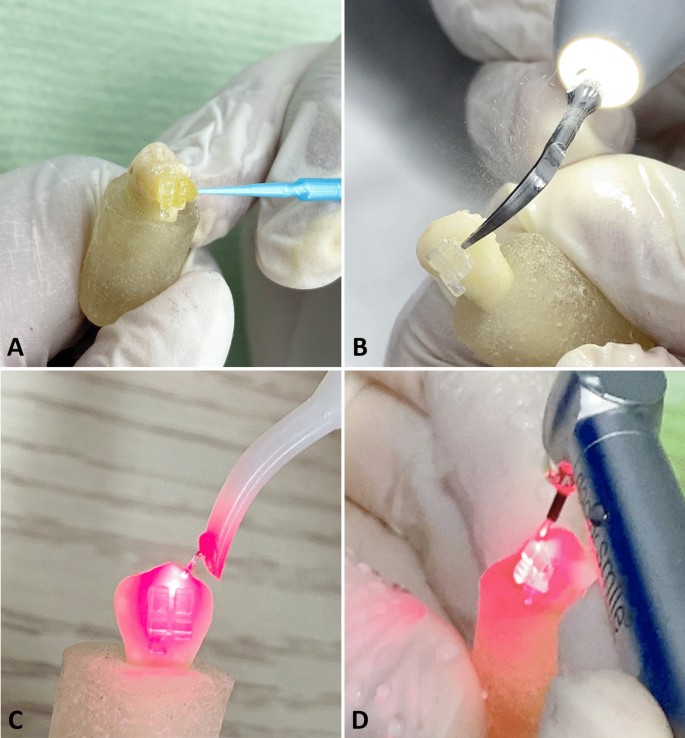
Shut-up view of the techniques used A Peppermint oil awarding, B Ultrasonic application, C Diode laser application, D Er:YAG laser application
Outcome assessment
SBS was tested for each bracket in all the 5 groups using a universal testing machine (LIoyd Instruments Ltd, United Kingdom) through the application of an occlusogingival load with a crosshead speed of 1 mm/min. (Fig. 2) The load at which failure occurred, was recorded for each sample. To express the bond strength in megapascals (MPa), failure load was divided past the bracket base area.
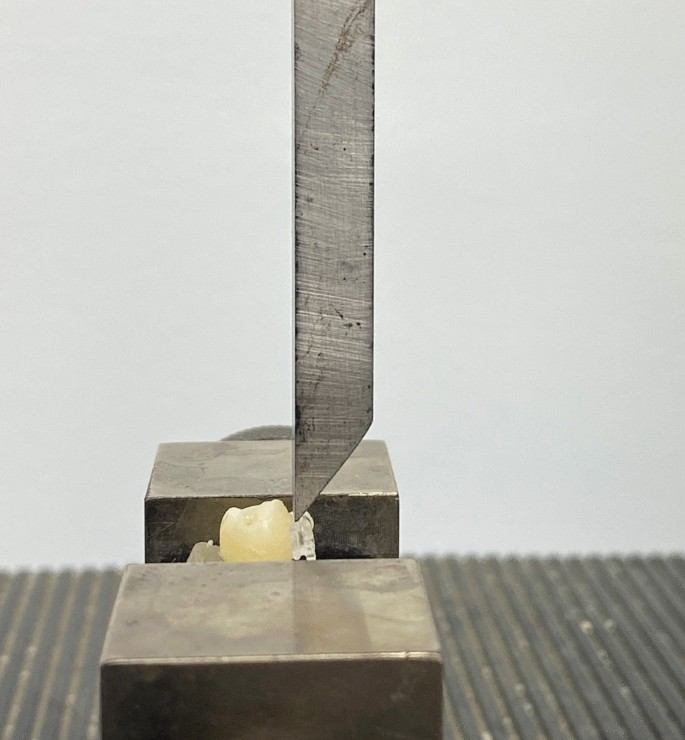
Shear bonding strength test of a sample- lateral view
ARI was adamant after bracket removal using stereomicroscope (Olympus, Tokyo, Nippon) at × 20 magnification. (Fig. iii) ARI scores ranged from 0 to three as follows:
-
Score 0—no adhesive remaining on the molar surface.
-
Score one—less than half of the adhesive remaining on the tooth surface.
-
Score two—more than than one-half of the adhesive remaining on the tooth surface.
-
Score 3—all the adhesive remaining on the tooth surface.
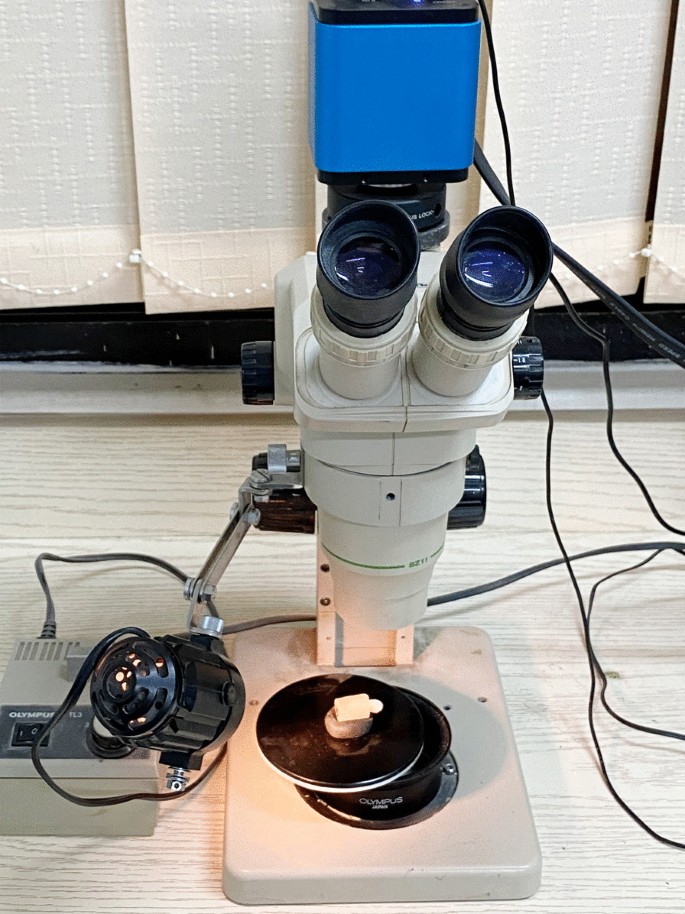
Stereomicroscope
Intra-examiner reliability was tested past rescoring of the specimens afterwards 2 weeks following the initial scoring. Kappa exam exhibited very expert intra-examiner reliability.
Enamel microstructure of specimen was evaluated using scanning electron microscopy (SEM) (Jeol JSM-IT200, Tokyo, Japan). (Fig. iv) A menses chart showing the applied methodology is shown in Fig. 5.
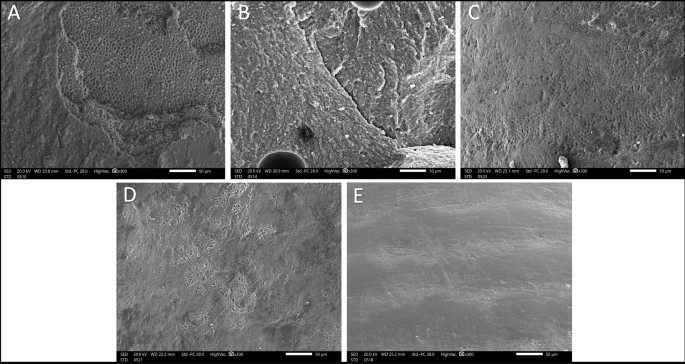
SEM images; A group I, B grouping II, C grouping III, D group IV, Eastward group 5 (original magnification × 300)
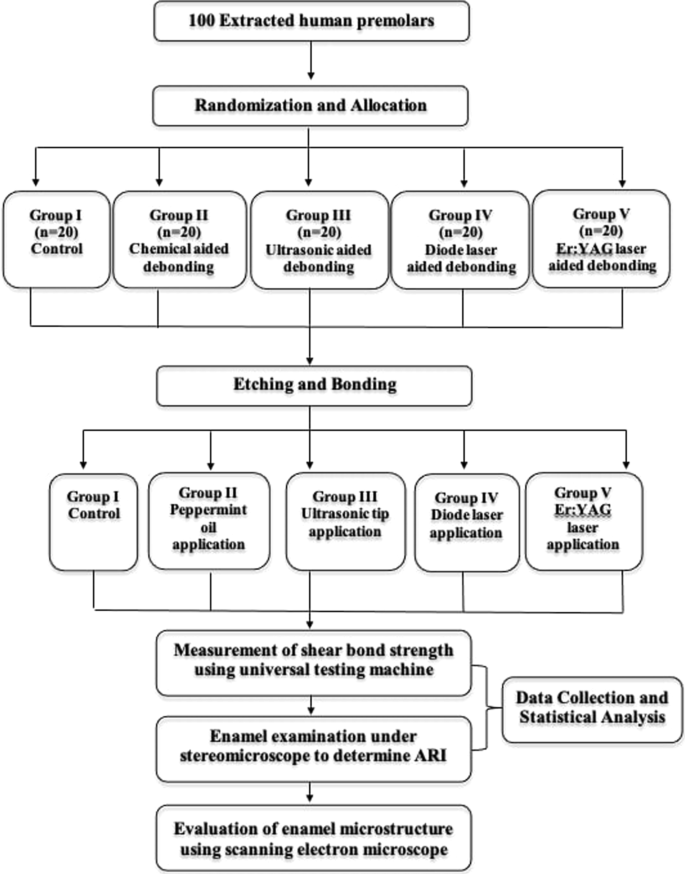
Flow chart summarizing the applied methodology
Statistical analysis
SBS values were described using range (minimum and maximum), hateful, standard deviation, median and interquartile range. Frequencies and percentages were calculated for ARI. F-examination (ANOVA) was used for SBS to compare between more than two groups, and Post Hoc test (Tukey) for pairwise comparisons. Comparison between unlike groups was done using Chi-square test for ARI. Correction for chi-square when more twenty% of the cells accept expected count less than 5, was washed using Monte Carlo correction. Significance of the obtained results was judged at the v% level (P ≤ 0.05). Data were analyzed using IBM SPSS software package version twenty.0.
Results
Shear bail strength
Descriptive analysis and analytical statistics of SBS of the five groups are depicted in Table i. Graphical comparing betwixt the five groups co-ordinate to mean SBS is shown in Fig. 6. The results of SBS showed a statistically significant difference (P = 0.0002). A statistically pregnant less SBS was found in group III (P = 0.039), grouping Iv (P = 0.035), and grouping V (P = 0.001) compared to group I (control group). A statistically significantly less SBS was found in grouping 5 (P = 0.004) compared to group II. There were no other significant differences between the groups with regard to SBS.
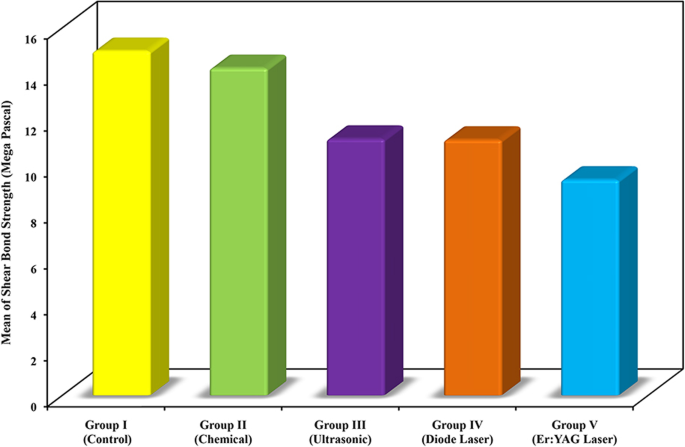
Graphical comparing between the five groups according to mean SBS
Agglutinative remnant index
Descriptive assay and analytical statistics of ARI of the five groups are reported in Table 2. Graphical comparison between the v groups according to ARI is presented in Fig. 7. Statistically significant higher ARI was found solely in group Five when compared to grouping I (P = 0.0002), group 2 (P = 0.0002), group Iii (P = 0.006), and grouping 4 (P = 0.606). No other significant differences were establish betwixt the groups with regard to ARI.
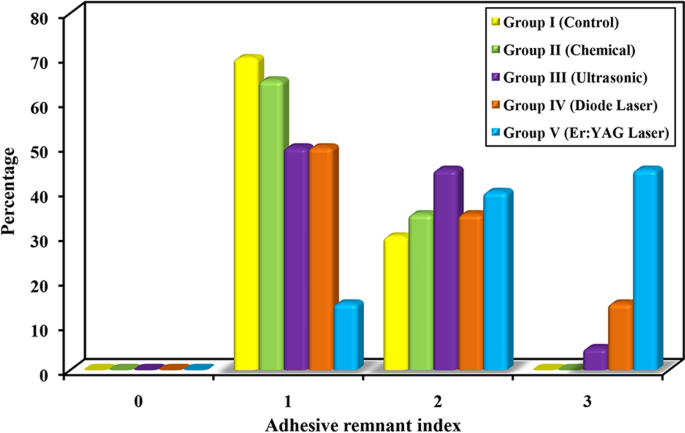
Graphical comparison betwixt the five groups co-ordinate to ARI
SEM revealed extensive mass loss in the form of love comb alterations, apparent cracks, and erosions in group I and II. Fine voids, facets, scratches, and irregularities in various degrees were observed in in group Three and IV. Intact enamel microstructure with fiddling alterations was found in group V (Fig. v).
Word
The present study aimed to evaluate and compare effects of dissimilar techniques for debonding ceramic brackets; chemical (peppermint oil), ultrasonic, diode light amplification by stimulated emission of radiation, and Er:YAG laser application to a control grouping in terms of SBS and ARI.
Various types of chemic agents were investigated with that regard. Acetone and ethanol were tested with unlike concentrations [xl]. The rationale was based on their power to dissolve the orthodontic adhesive [41]. Nevertheless, neither statistically significant divergence in SBS nor ARI were institute [42]. Even when longer application time was used, the results gave no support to that hypothesis [43]. On the contrary, eucalyptol in either gel or liquid forms significantly decreased SBS when used in conjunction with metal or ceramic brackets [19, 44]. The present study found no statistically significant deviation with regard to SBS and ARI when peppermint oil was used, likewise some previous results [18]. Too, SEM depicted extensive enamel alterations. Longer application menstruation yielded appreciable adhesive softening in a previous study, notwithstanding it did non reach statistical significance [xix, 45].
Ultrasonic devices take been used for brackets aided debonding and consecutively adhesive removal [19, 46]. The present study plant out that ultrasonic application significantly decreased SBS of ceramic brackets. This was in line with Bonetti et al. [eighteen] who demonstrated that ultrasonic instrumentation via both 45 and 0 degree scaler tip angulation significantly decreased SBS values. The results were as well in accord with the ii parts study of Bishara and Trulove [5] who found less incidence of subclass failure and decreased likelihood of enamel damage with ultrasonic method. Yet, no statistically significant difference was found in the present study with regard to ARI, similar to a previously reported results by others [17]. SEM also showed various degrees of voids.
Diode light amplification by stimulated emission of radiation with its compact size gave information technology the superiority over other types of lasers. In turn, the use of diode laser for aided debonding of ceramic brackets would be a privilege. Too much debate existed apropos the efficiency of diode laser [5, 15]. This is complicated with the fact that neither a protocol with fixed laser parameters nor clear guidelines be [17]. The present study found a significant reduction of SBS when diode laser was used. In fact, diode laser yields a coherent radiation with consistent waves which attribute to light amplification by stimulated emission of radiation aided debonding via thermal softening of the adhesive. This finding is in agreement with others [32, 47]. Yet, information technology contradicts the findings of Ivanov [47] who found lack of statistical significance. Multiple factors may have contributed to making the findings of the present study different from it. Showtime, the difference between the subclass pad blueprint. Brackets used in Ivanov study had a patent base with alumina on the heart, unlike the ones used in the present written report with base coating, employed via double fusing method. 2nd, the difference in the research design. Power and wavelength of the laser, lasing fourth dimension, sample size, and type of the adhesive used were all different. On the other paw, ARI analysis showed no significant difference in the present study when diode laser was used, with enamel alterations exhibited under SEM in form of fine scratches. This was in agreement with previous piece of work carried out past others [32,33,34, 48]. However, Almohaimeed and Abdelhalim [47] and Anand et al. [32, 48, 49] found a meaning increase of ARI. Even so, Stein et al. [33] reported a statistically significant reduction. Once again, the rationale behind inconsistent findings might be the different practical methodology.
Er:YAG light amplification by stimulated emission of radiation yielded promising results when used in prosthodontic field [34]. There is lack of literature on the implication of Er:YAG laser in orthodontics. It is worth mentioning that Er:YAG exhibited less thermal event than CO2 and Nd:YAG laser [50]. Additionally, It is easily absorbed within h2o containing tissues [51, 52]. In other words, orthodontic adhesive tends to absorb Er:YAG light amplification by stimulated emission of radiation energy efficiently. Yet, its relatively big size remains one of the major downsides. The nowadays study demonstrated a statistically meaning reduction of SBS when Er:YAG laser was used. This was in agreement with others [39]. Mundethu et al. [53] confirmed the findings and revealed that continuous Er:YAG lasing with no adjunct external force volition eventually cause the brackets to bound off the teeth. Sedky and Gutknecht [29, 30, 37, 38] compiled the aforementioned protocol with the employ of Er,Cr:YSGG light amplification by stimulated emission of radiation instead. The mechanism of how SBS decreased is related to the debonding force created from photoablation. The theory behind is explained past the fact that uncured monomer and the water every bit a components of the adhesive likely blot laser energy, expand, and thereafter vaporize, giving ascent to subsurface pressure and consequently micro-explosions, which crusade decomposition of the resin matrix and thereby decrease SBS of the brackets [54]. This phenomenon also elucidated why we primarily chose the one pace adhesive that incorporates the primer into the paste. Contrastingly, ARI showed a statistically significant higher values when Er:YAG laser was used. This was consistent with results reported by others [55]. Notwithstanding, Dostalova et al. [56] and Sedky and Gutknecht [29, thirty, 37] contradicted this finding. This might be attributed to the different laser parameters and unlike laser types used with the work of Dostalova et al. [57] and Sedky and Gutknecht, respectively. The all-time example scenario sought would be the increased ARI, which reflected the conservative effect with minimal damage to the enamel [55].
The results of SBS values revealed a significant reduction in all study groups compared to control except the chemical aided debonding, where negligible decrease was observed. In essence, information technology was believed that a forcefulness in the range of half dozen to viii MPa is crucial to debond orthodontic brackets [57]. The but group that showed a merely acceptable values was the Er:YAG laser aided debonding, with a mean SBS of 9.39 MPa. This could make it the technique of choice for debonding ceramic brackets. Despite a pregnant reduction of SBS in ultrasonic and diode light amplification by stimulated emission of radiation aided debonding, hateful SBS in these groups was relatively college than the acceptable range (eleven.17 and 11.13 MPa, respectively).
ARI analysis was employed via measurement of the amount of remaining agglutinative. The findings of the nowadays report exhibited a college mean of ARI in all examination groups compared to control, even though the only grouping that reached statistical significance was the Er:YAG laser aided debonding, with little enamel microstructure alterations. Again, college ARI scores markedly reflect the reduction of enamel damage [58, 59]. Nonetheless, increased chair time for the purpose of adhesive removal remained inevitable [60].
Conclusions
-
Er:YAG laser facilitated debonding of ceramic brackets via reduction of SBS and increase of ARI. This may alleviate the risk of enamel impairment.
-
Ultrasonic and diode laser aided debonding of ceramic brackets significantly decreased SBS. Yet, ARI in both groups revealed no significant difference.
-
Chemic aided debonding of ceramic brackets via peppermint oil had niggling upshot on SBS and ARI. Hence, this method cannot be recommended without further development.
Availability of data and materials
The datasets used during the current written report are bachelor from the corresponding author on reasonable request. All data analyzed during this written report are included in this published article in the form of tables and figures.
Abbreviations
- Er:YAG:
-
Erbium-doped yttrium aluminum garnet
- Er,Cr:YSGG:
-
Erbium, chromium-doped yttrium, scandium, gallium and garnet
- Nd:YAG:
-
Neodymium-doped yttrium–aluminium garnet
- COtwo :
-
Carbon dioxide
- SBS:
-
Shear bond strength
- ARI:
-
Adhesive remnant index
- MPa:
-
Megapascal
- SEM:
-
Scanning electron microscope
References
-
Jena AK, Duggal R, Mehrotra AK. Concrete properties and clinical characteristics of ceramic brackets: a comprehensive review. Trends Biomater Artif Organs. 2007;20(2):123–38.
-
Jeiroudi MT. Enamel fracture acquired by ceramic brackets. Am J Orthod Dentofac Orthop. 1991;99(2):97–9.
-
Karamouzos A, Athanasiou AE, Papadopoulos MA. Clinical characteristics and backdrop of ceramic brackets: a comprehensive review. Am J Orthod Dentofac Orthop. 1997;112(1):34–40.
-
Hossaini S, Bahador A. Application of the high intensity laser therapies on ceramic brakets debonding: a literature review. Ann Dent Spec. 2018;6(1):363–6.
-
Bishara SE, Trulove TS. Comparisons of different debonding techniques for ceramic brackets: an in vitro study. Office I. Background and methods. Am J Orthod Dentofacial Orthop. 1990;98(2):145–53.
-
Bishara SE, Trulove TS. Comparisons of dissimilar debonding techniques for ceramic brackets: an in vitro study: Part II. Findings and clinical implications. Am J Orthod Dentofac Orthop. 1990;98(three):263–73.
-
Ghazanfari R, Nokhbatolfoghahaei H, Alikhasi Chiliad. Laser-aided ceramic bracket debonding: a comprehensive review. J Lasers Med Sci. 2016;7(1):2–11.
-
Sheridan JJ, Brawley G, Hastings J. Electrothermal debracketing Function I. An in vitro study. Am J Orthod. 1986;89(ane):21–seven.
-
Deepa K, Ali H, Mohan A. Ceramic bracket debonding: a review. Indian J Res. 2018;7(1):1991–three.
-
Swinburne ML, Willmot D, Patrick D. The use of debonding microspheres in electrothermal debonding. Eur J Orthod. 2011;33(4):407–12.
-
Jost-Brinkmann PG, Stein H, Miethke RR, Nakata Thou. Histologic investigation of the human pulp later thermodebonding of metal and ceramic brackets. Am J Orthod Dentofac Orthop. 1992;102(five):410–7.
-
Oliver RG. The effect of different methods of bracket removal on the amount of residual adhesive. Am J Orthod Dentofac Orthop. 1988;93(3):196–200.
-
Bishara SE, Ostby AW, Laffoon J, Warren JJ. Enamel cracks and ceramic bracket failure during debonding in vitro. Angle Orthod. 2008;78(half dozen):1078–83.
-
Liu JK, Chung CH, Chang CY, Shieh D. Bond force and debonding characteristics of a new ceramic bracket. Am J Orthod Dentofac Orthop. 2005;128(6):761–five.
-
Bishara SE, Trulove TS. Comparisons of different debonding techniques for ceramic brackets: an in vitro report. Role II. Findings and clinical implications. Am J Orthod Dentofac Orthop. 1990;98(3):263–73.
-
Krell KV, Courey JM, Bishara SE. Orthodontic bracket removal using conventional and ultrasonic debonding techniques, enamel loss, and time requirements. Am J Orthod Dentofac Orthop. 1993;103(three):258–66.
-
Bonetti GA, Parenti SI, Ippolito DR, Gatto MR, Checchi Fifty. Effects of ultrasonic instrumentation with different scaler-tip angulations on the shear bail strength and bail failure mode of metallic orthodontic brackets. Korean J Orthod. 2014;44(1):44–ix.
-
Larmour CJ, McCabe JF, Gordon PH. An ex vivo investigation into the effects of chemic solvents on the debond behaviour of ceramic orthodontic brackets. Br J Orthod. 1998;25(1):35–ix.
-
Yu C-C, Yu J-H, Lin H-J. An investigation of the furnishings of chemical reagents on the shear bonding forces of orthodontic metal brackets. Dentistry. 2016;6(6):six–11.
-
Kanth D, Peddu R, Mallavarapu One thousand, Pattan SK, Adusumillie S. Evaluation of enamel surface characteristics following debonding of ceramic brackets using various debondibg techniques. Indian J Dent Sci. 2014;6(1):123–half dozen.
-
Obata A, Tsumura T, Niwa K, Ashizawa Y, Deguchi T, Ito G. Super pulse CO2 light amplification by stimulated emission of radiation for bracket bonding and debonding. Eur J Orthod. 1999;21(2):193–8.
-
Iijima Yard, Yasuda Y, Muguruma T, Mizoguchi I. Effects of CO2 laser debonding of a ceramic subclass on the mechanical properties of enamel. Angle Orthod. 2010;80(six):1029–35.
-
Macri R, Lima F, Bachmann 50, Galo R, Romano F, Borsatto M, et al. CO2 laser as auxiliary in the debonding of ceramic brackets. Lasers Med Sci. 2014;30(7):1835–41.
-
Hayakawa K. Nd:YAG laser for debonding ceramic orthodontic brackets. Am J Orthod Dentofac Orthop. 2005;128(5):638–47.
-
Han X, Liu X, Bai D, Meng Y, Huang 50. Nd:YAG Light amplification by stimulated emission of radiation-aided ceramic brackets debonding: furnishings on shear bail strength and enamel surface. Appl Surf Sci. 2008;255(2):613–five.
-
Nasiri M, Mirhashemi A, Etemadi A, Kharazifard MJ, Borujeni ES, Mahd MJ, et al. Evaluation of the shear bond strength and agglutinative remnant alphabetize in debonding of stainless steel brackets assisted with Nd:YAG laser irradiation. Front Dent. 2019;16(1):37–44.
-
Al-maajoun MK, Henar TE, Tost AE, Terren CA. CO2 and Er, Cr:YSGG laser applications in debonding ceramic materials: an in vitro study. Open J Paring Oral Med. 2017;5(3):25–thirty.
-
Mirhashemi AH, Hossaini SMH, Etemadi A, Kharazifard MJ, Bahador A, Soudi A. Event of Er:YAG and Er, Cr:YSGG lasers on ceramic bracket debonding from blended blocks. Forepart Dent. 2019;16(2):88–95.
-
Oztoprak MO, Nalbantgil D, Erdem Equally, Tozlu M, Arun T. Debonding of ceramic brackets by a new scanning laser method. Am J Orthod Dentofac Orthop. 2010;138(2):195–200.
-
Nalbantgil D, Oztoprak O, Tozlu Yard, Arun T. Furnishings of different application durations of ER:YAG laser on intrapulpal temperature change during debonding. Lasers Med Sci. 2010;26(6):735–40.
-
Nalbantgil D, Tozlu M, Oztoprak MO. Pulpal thermal changes following Er-YAG laser debonding of ceramic brackets. Sci Globe J. 2014;2014.
-
Feldon PJ, Murray PE, Burch JG, Meister One thousand, Freedman MA. Diode laser debonding of ceramic brackets. Am J Orthod Dentofac Orthop. 2010;138(4):458–62.
-
Almohaimeed M, Abdelhalim S. Diode light amplification by stimulated emission of radiation de-bonding of pre-coated ceramic brackets. J Am Sci. 2013;nine(5s):1545–1003.
-
Anand P, Anand PB, Prabhakar R, Rajvikram Due north, Rajakumar P, Atali VR, et al. Immediate and delayed furnishings of diode laser on debonding of ceramic brackets: an in vitro study. J Contemp Paring Pract. 2016;17(4):275–81.
-
Yassaei Due south, Aghili H, Ebrahimi-Nik Z. Different modes of diode light amplification by stimulated emission of radiation irradiation: furnishings on enamel surface and intrapulpal temperature at debonding. Light amplification by stimulated emission of radiation Ther. 2018;27(3):214–viii.
-
Tocchio RM, Williams PT, Mayer FJ, Standing KG. Light amplification by stimulated emission of radiation debonding of ceramic orthodontic brackets. Am J Orthod Dentofac Orthop. 1993;103(2):155–62.
-
Tozlu M, Oztoprak MO, Arun T. Comparison of shear bond strengths of ceramic brackets after different time lags between lasing and debonding. Lasers Med Sci. 2012;27(6):1151–5.
-
Alakussabuncuoglu F, Ersahan Due south, Erturk Due east. Debonding of ceramic brackets by Er:YAG laser. J Istanbul Univ Fac Dent. 2016;l(ii):24–thirty.
-
Wigdor H, Abt E, Ashrafi S, Walsh JT. The result of lasers on dental hard tissues. J Am Dent Assoc. 1993;124(2):65–lxx.
-
Daniel W. Biostastics a foundation for assay in health science. In: sixth ed. Newyork, USA: John Willey and sons Inc; 1995.
-
Saghaei Thousand. Random resource allotment software for parallel group randomized trials. BMC Med Res Methodol. 2004;4(1):26.
-
Van Landuyt L, Snauwaert J, De Munck J, Peumans K, Yoshida Y, Poitevin A, et al. Systematic review of the chemical composition of contemporary dental adhesives. Biomaterials. 2007;28(26):3757–85.
-
Garcia FC, Wang L, Pereira LC, Silva SM, Junior LM, Carrilho MR. Influences of surface and solvent on retention of HEMA/mixture components after evaporation. J Dent. 2010;38(i):44–9.
-
Santana RM, Rached RN, Souza EM, Guariza-Filho O, Camargo ES, Pithon MM, et al. Effect of organic solvents and ultrasound on the removal of orthodontic brackets. Orthod Craniofacial Res. 2016;19(iii):137–44.
-
Riyanti A, Siregar E, Anggani HS. Shear bond strength of bisphenol a-glycidyl methacrylate adhesive resin after application of eucalyptus oil before debonding metallic orthodontic bracket. Int J Appl Pharm. 2019;11(i):187–9.
-
Larmour CJ, Chadwick RG. Effects of a commercial orthodontic debonding agent upon the surface microhardness of two orthodontic bonding resins. J Dent. 1995;23(1):37–40.
-
Ivanov PI. Investigation of diode laser debonding of ceramic orthodontic brackets. Nova Southeastern Academy; 2012.
-
Sinaee N, Salahi S, Sheikhi M. Evaluation of the effect of diode laser for debonding ceramic brackets on nanomechanical properties of enamel. Dent Res J (Isfahan). 2018;15(5):354–threescore.
-
Yassaei S, Soleimanian A, Nik E. Effects of diode laser debonding of ceramic brackets on enamel surface and pulpal temperature. J Contemp Dent Pract. 2015;16(4):270–4.
-
Stein S, Kleye A, Schauseil M, Hellak A, Korbmacher-Steiner H, Braun A. 445-Nm diode laser-assisted debonding of self-ligating ceramic brackets. Biomed Tech. 2017;62(5):513–20.
-
Rechmann P, Buu NCH, Rechmann BMT, Le CQ, Finzen FC, Featherstone JDB. Laser all-ceramic crown removal-a laboratory proof of principle study-phase 1 material characteristics. Lasers Surg Med. 2014;46(8):628–35.
-
Sari T, Tuncel I, Usumez A, Gutknecht Due north. Transmission of Er:YAG laser through unlike dental ceramics. Photomed Laser Surg. 2014;32(1):37–41.
-
Bader C, Krejci I. Indications and limitations of Er:YAG laser applications in dentistry. Am J Dent. 2006;19(iii):178–86.
-
Mundethu A, Gutknecht Due north, Franzen R. Rapid debonding of polycrystalline ceramic orthodontic brackets with an Er:YAG laser: an in vitro study. Lasers Med Sci. 2014;29(five):1551–6.
-
Sedky Y, Gutknecht N. The effect of using Er, Cr:YSGG laser in debonding stainless steel orthodontic brackets: An in vitro study. Lasers Paring Sci. 2018;ii(1):xiii–eight.
-
Apel C, Franzen R, Meister J, Sarrafzadegan H, Thelen S, Gutknecht N. Influence of the pulse duration of an Er:YAG laser system on the ablation threshold of dental enamel. Lasers Med Sci. 2002;17(4):253–7.
-
Dostalova T, Jelinkova H, Remes M, Šulc J, Němec M. The use of the Er: YAG light amplification by stimulated emission of radiation for subclass debonding and its event on enamel damage. Photomed Laser Surg. 2016;34(9):394–9.
-
Bishara SE, Ostby AW, Laffoon JF, Warren J. Shear bail strength comparison of 2 adhesive systems following thermocycling. Bending Orthod. 2007;77(2):337–41.
-
Holzmeier M, Schaubmayr M, Dasch W, Hirschfelder U. A new generation of self-carving adhesives: comparison with traditional acid compose technique. J Orofac Orthop. 2008;69(2):78–93.
-
Reynolds IR. A review of directly orthodontic bonding. Br J Orthod. 1975;two(iii):171–8.
Acknowledgements
Not applicable.
Author information
Affiliations
Contributions
AK conducted the applied work, wrote the manuscript, and reviewed the statistics. NT and AE contributed to the pattern of the written report, reviewed and critically revised the manuscript. All authors read and canonical the final manuscript.
Corresponding author
Ethics declarations
Ethics approval and consent to participate
The study was approved by the institutional review board at the Faculty of Dentistry, Alexandria Academy (IRB:00010556–IORG:0008839). Informed consent was obtained from all subjects or legal guardians.
Consent for publication
Not applicable.
Competing interests
The authors declare that they accept no competing interests.
Additional information
Publisher'south Note
Springer Nature remains neutral with regard to jurisdictional claims in published maps and institutional affiliations.
Rights and permissions
Open up Access This commodity is licensed under a Artistic Commons Attribution 4.0 International License, which permits utilise, sharing, adaptation, distribution and reproduction in any medium or format, equally long every bit you requite appropriate credit to the original author(south) and the source, provide a link to the Creative Eatables licence, and indicate if changes were made. The images or other tertiary party fabric in this article are included in the article's Creative Commons licence, unless indicated otherwise in a credit line to the material. If cloth is non included in the article's Artistic Commons licence and your intended apply is not permitted by statutory regulation or exceeds the permitted use, y'all will need to obtain permission directly from the copyright holder. To view a copy of this licence, visit http://creativecommons.org/licenses/by/4.0/. The Creative Eatables Public Domain Dedication waiver (http://creativecommons.org/publicdomain/zero/1.0/) applies to the information made available in this article, unless otherwise stated in a credit line to the data.
Reprints and Permissions
About this article
Cite this article
Khalil, A.Due south., Tamish, Due north.Thou. & Elkalza, A.R. Cess of chemic, ultrasonic, diode laser, and Er:YAG laser awarding on debonding of ceramic brackets. BMC Oral Wellness 22, 79 (2022). https://doi.org/x.1186/s12903-022-02111-seven
-
Received:
-
Accepted:
-
Published:
-
DOI : https://doi.org/10.1186/s12903-022-02111-seven
Keywords
- Ceramic brackets
- Debonding
- SBS
- ARI
Source: https://bmcoralhealth.biomedcentral.com/articles/10.1186/s12903-022-02111-7
0 Response to "Clinical Characteristics and Properties of Ceramic Brackets a Comprehensive Review"
Post a Comment